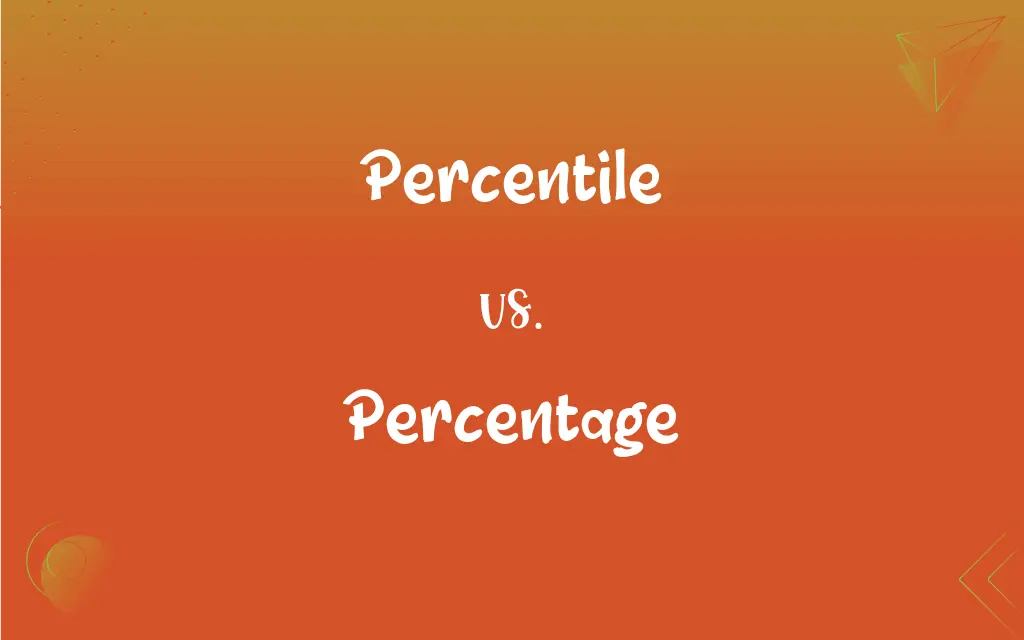Percentile vs. Percentage: What's the Difference?
Edited by Aimie Carlson || By Harlon Moss || Updated on October 20, 2023
A percentile indicates a relative rank within a set, while a percentage represents a proportion out of 100.

Key Differences
A percentile refers to a measure that tells us what proportion of a given dataset falls below a particular value. For instance, if a student scores in the 90th percentile on a test, they've scored higher than 90% of the other students. On the other hand, a percentage is a mathematical representation of a ratio as a fraction of 100. It tells you the part of a whole.
When considering a dataset, the percentile gives a comparative standing. If someone is in the 75th percentile for height, it means they are taller than 75% of their peers. Percentage, in contrast, would denote the actual fraction of a particular subset. For example, if 15% of people in a room wear glasses, that's a direct proportion, not a ranking.
Percentile is commonly used in standardized testing or any situation where you want to compare an individual's performance against others. It offers context about relative standing. Percentage is more ubiquitous, used in various contexts, from finance to science, indicating parts of a whole.
In the context of growth charts, a child's weight might be in the 80th percentile, meaning they weigh more than 80% of children their age. However, if we say 60% of children in a school are vaccinated, we're using percentage to convey a proportion of the total number of children.
To sum it up, while both percentile and percentage quantify data, they serve different purposes. Percentile ranks data points in a set, while percentage communicates a portion out of a total 100.
ADVERTISEMENT
Comparison Chart
Definition
A relative rank in a dataset.
A proportion out of 100.
Usage
Comparison within a set.
Expressing a part of a whole.
Representation
A value from 1 to 100 showing relative standing.
A value from 0 to 100 showing a fraction of the total.
Common Context
Standardized tests, growth charts.
Finance, science, daily life.
Mathematical Relation
Rank of an individual divided by total number in a set.
Part divided by whole, then multiplied by 100.
ADVERTISEMENT
Percentile and Percentage Definitions
Percentile
A measure indicating the value below which a given percentage of observations fall.
In a marathon, finishing in the 95th percentile means you finished faster than 95% of participants.
Percentage
A numerical expression used to denote a specific portion of a total amount.
After the rainfall, there was a 10% increase in the reservoir's water levels.
Percentile
A way to understand an individual's position relative to others in a set.
If a baby's height is in the 60th percentile, they're taller than 60% of babies their age.
Percentage
A way to express a proportion in terms of a whole.
The shirt was on sale, so I received a 15% discount.
Percentile
A value on a scale of one hundred that indicates the percent of a distribution that is equal to or below it.
A household income in the 80th percentile exceeds that of 80% of households surveyed.
Percentage
A fraction or ratio represented out of 100.
Only 20% of the students passed the exam.
Percentile
A ranking system that sorts data points within a dataset.
In standardized testing, a 70th percentile score denotes better performance than 70% of takers.
Percentage
A quantitative method to describe one part of a set relative to the whole set.
Approximately 65% of adults in the city have received a college degree.
Percentile
A statistical tool to compare an individual data point's standing within a distribution.
Being in the top 10th percentile of a university class means outperforming 90% of classmates.
Percentage
The result obtained by multiplying a quantity by a percent.
The company experienced a 5% growth in sales this quarter.
Percentile
Any of the groups that result when a frequency distribution is divided into 100 groups of equal size.
Percentage
A fraction or ratio with 100 understood as the denominator; for example, 0.98 equals a percentage of 98.
Percentile
Any of the values that separate each of these groups.
Percentile
(statistics) Any of the ninety-nine points that divide an ordered distribution into one hundred parts, each containing one per cent of the population.
Percentile
(statistics) Any one of the hundred groups so divided.
He is highly intelligent – he has an IQ in the top percentile.
Percentile
(statistics) any of the 99 numbered points that divide an ordered set of scores into 100 parts each of which contains one-hundredth of the total
FAQs
How is percentage calculated?
Percentage is calculated by dividing the part by the whole and multiplying by 100.
What does percentile convey in a dataset?
Percentile indicates a data point's relative rank or position within the dataset.
Can you give an example of when percentage might be more useful than percentile?
When determining what fraction of a group has a particular attribute, like "30% of students wear glasses."
Is the 50th percentile the same as the median?
Yes, the 50th percentile is equivalent to the median value in a dataset.
Do percentile and percentage have the same origin?
Both stem from the Latin word "centum" meaning "hundred," but they're used differently in statistics and math.
How do I interpret a 25th percentile score?
It means the score is higher than 25% of the scores in the dataset, but lower than the remaining 75%.
Can a percentile be over 100?
No, percentiles range from 1 to 100, representing relative positions in a dataset.
Can one data set have both percentiles and percentages?
Yes, for different purposes. E.g., "90th percentile in test scores" and "20% received an A grade."
Why do we often see percentages in sales and discounts?
Because percentages effectively convey the proportion of the original price that's being reduced.
Are there other measures related to percentile and percentage?
Yes, quartiles and deciles are related to percentiles, and ratio and proportion relate to percentage.
How is percentage typically represented?
Percentage is represented as a fraction or ratio out of 100.
Is percentage always less than or equal to 100?
Typically, yes. However, in some contexts like growth or change, percentages can exceed 100.
How are percentage points different from a percentage?
Percentage points refer to the arithmetic difference between percentages. If the rate goes from 5% to 7%, it's risen by 2 percentage points.
What's a real-world use of percentile?
Medical professionals use growth percentiles to track children's development compared to peers.
Does a higher percentile always indicate a better result?
Typically, but context matters. In some cases, like risk assessments, a higher percentile might indicate more risk.
In what context might one use percentile?
Percentile is often used in test scores or growth charts to compare an individual's standing.
Is a 99th percentile score always better than a 90% score?
Yes, in terms of ranking. 99th percentile means outperforming 99% of peers, while 90% means outperforming 90%.
How can I convert a fraction to a percentage?
Divide the numerator by the denominator and multiply by 100.
Can percentages be negative?
Yes, in contexts like decline or loss, percentages can be negative.
How does percentile differ from percentage in data interpretation?
While percentile ranks data points, percentage indicates a part of the whole.
About Author
Written by
Harlon MossHarlon is a seasoned quality moderator and accomplished content writer for Difference Wiki. An alumnus of the prestigious University of California, he earned his degree in Computer Science. Leveraging his academic background, Harlon brings a meticulous and informed perspective to his work, ensuring content accuracy and excellence.
Edited by
Aimie CarlsonAimie Carlson, holding a master's degree in English literature, is a fervent English language enthusiast. She lends her writing talents to Difference Wiki, a prominent website that specializes in comparisons, offering readers insightful analyses that both captivate and inform.































































